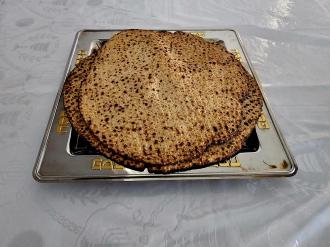Question #1: How many mitzvos?
“Is keeping kosher more than one mitzvah?”
Question #2: Food for thought
“Am I required to eat each of the kosher species?”
Question #3: Check your scales
“Must I check fish for scales each time I purchase one?”
Introduction:
Two weeks ago we discovered that when the Torah discusses which species are kosher, it says (in parshas Shemini), “These are the living things from which you may eat,” which the midrashei halacha and the Rambam count as mitzvos aseih. We noted that the Rambam considers these as lav haba miklal aseih, a prohibition verbalized as a mitzvas aseih, which is sometimes called an issur aseih. We also noted that the Rambam counts four different mitzvos aseih, one to eat only kosher animals, one to eat only kosher fish, one to eat only kosher fowl, and one to eat only kosher grasshoppers. We also learned that the Rambam explains that he wrote the Sefer Hamitzvos to explain the rules that govern what is included in the listing of the 613 mitzvos. We now continue with part two of our article.
What type of positive mitzvah?
The first half of Sefer Hamitzvos consists of fourteen rules, called sherashim, that the Rambam established to determine whether something is counted as one of the 613 mitzvos or not. In the sixth shoresh, the Rambam rules that if a mitzvah is commanded in the Torah both as a positive commandment and as a negative prohibition, then it is counted as two of the 613 mitzvos -- both as a positive mitzvah and a negative one. The Rambam explains that there are three types of mitzvos aseih in which this occurs.
1. In some instances, there is a positive mitzvah that is a flipside of the negative prohibition. For example, someone who observes Shabbos or Yom Tov fulfills a positive mitzvah (Pesachim 84a). There is also a negative prohibition which one violates by performing prohibited activity on Shabbos or Yom Tov.
Similarly, there is a positive mitzvah to observe shemittah, and negative ones involving performing prohibited activity during shemittah. Another example is fasting on Yom Kippur, which involves both a positive mitzvah of afflicting oneself and a lo sa’aseh.
2. A second type of positive mitzvah that accompanies a lo sa’aseh is what is called a lav shekadmo aseih -- there is a mitzvah to do something, but one who violates the intent of the positive mitzvah will, at that time, also violate a lo sa’aseh. Two examples of this rule are the cases of the oneis and the motzi shem ra, both of whom are required by a mitzvas aseih to marry and remain married to the wronged woman (should she agree). Should he subsequently divorce her, he will violate a lo sa’aseh.
3. A third type of positive mitzvah that accompanies a lo sa’aseh is called lav hanitak le’aseih, in which the mitzvas aseih is the instruction that the Torah provided if someone violates the lo sa’aseh. Here are two examples of this situation: The mitzvas lo sa’aseh of nosar is to make sure not to leave over edible parts of a korban past the time that the Torah established for that particular korban. One who does leave over and violates the lo sa’aseh now becomes commanded to observe a mitzvah aseih of burning the leftovers.
A second example is the mitzvah of shiluach hakein, in which one is prohibited from taking the mother bird while she is fulfilling her motherly duties to her eggs or young. One who violates this prohibition by seizing the mother bird is now required to observe the positive mitzvah of setting her free.
We are now faced with a question: If the word tocheilu is a positive mitzvah, what is the Torah commanding us to do? It certainly does not fit the second or third of the three categories mentioned above. The second category would mean that there is a positive mitzvah that one is required to perform whose result one now wishes to abrogate. The mitzvah of tocheilu certainly does not fit this category. Similarly, tocheilu cannot fit the third category, because this mitzvah is not correcting an error.
If tocheilu is included in the first category, it would mean that one who eats non-kosher violates an aseih, also. Whether we can look at the mitzvah this way appears to be the point of departure between the Rambam and the Ramban. The Ramban wrote the earliest commentary to the Rambam’s Sefer Hamitzvos, with a goal of explaining the Behag’s approach and answering the questions that the Rambam asks on the Behag. At times, the Ramban takes issue with some of the Rambam’s 14 rules. However, the Ramban accepts the Rambam’s sixth rule that a mitzvah, such as Shabbos or Yom Tov, when expressed by the Torah both in a positive way and a negative one, is counted twice, both as a mitzvas aseih and as a mitzvas lo sa’aseh. The Ramban disagrees with the Rambam regarding these four mitzvos of identifying kosher species.
To quote the Ramban, “I see in this matter a major dispute (between the Behag and the Rambam) and, without any question, one of the opinions is erroneous. There are instances in which there is both a lo sa’aseh and an aseih in the same topic; however, both are not counted as mitzvos. An example is the permitted and forbidden animals, fish and fowl, where the Torah includes a positive statement, ‘this is the animal that you may eat,’ and Chazal interpret this to be a mitzvas aseih. Similarly, when it says, ‘you may eat any pure bird’ and it is counted as a positive mitzvah. And again, when it says, ‘this you may eat, from whatever is in the water.’ It is obvious that the intent of the Torah is not to say that when one eats an animal or a fish with the proper kosher signs that one fulfills a mitzvah, and that someone who traps them and then does not eat them is in violation of his observance of a positive mitzvah. The intent, clearly, is that one may eat only these species and not the non-kosher ones. This is called a lo sa’aseh that is derived from a positive statement (in Hebrew, this is called a lav haba miklal aseih), whose purpose is to establish that someone who violates the lo sa’aseh also violates an aseih.”
The Ramban then notes that in all of these instances, the Rambam counts as positive mitzvos that one check whether a species of animal, bird, fish or grasshopper is kosher. However, concludes the Ramban, “The Behag did not count them, because they do not include a positive activity, whereas avoiding eating the prohibited is already included in the lo sa’aseh. Consequently, referring to the prohibition in a positive way does not add to the mitzvah count in these instances, just as repeating the lo sa’aseh several times does not add an extra lo sa’aseh to the mitzvah count.”
The last point raised by the Ramban is mentioned by the Rambam and others. The Torah often repeats a prohibition many times. When the additional pasuk does not add any new halachic information, the additional reference does not constitute an additional mitzvah.
Be positive!
Many authorities rally to address the final point of the Ramban, that the Rambam’s inclusion of these four positive mitzvos must include some additional component or ruling to the halacha. Additional support for this approach can be brought from the way the Rambam, himself, mentions these mitzvos. In all four instances, the Rambam writes that we are commanded to check for the signs that the particular species is kosher. And he writes this in two places, once in the Mishneh Torah and another time in the Sefer Hamitzvos. There is also one time in the Mishneh Torah where the Rambam writes that the mitzvah is to “know” the kosher signs. What exactly does this mitzvah of checking or knowing entail?
What does a mitzvah add?
Many approaches are suggested to explain what the positive mitzvah might be including, according to the Rambam. Some understand that the mitzvah requires that one be completely familiar with the simanim of the kosher species and have hands-on experience. Book knowledge that split hooves and chewing cud are kosher signs, without knowing what these two terms mean, does not fulfill the mitzvah (Darchei Teshuvah 79:1, quoting Korban Aharon and Yad David). It is somewhat implied by them that the mitzvah of studying Torah is fulfilled by knowing the laws, without necessarily knowing what one is to look for; but, without hands-on experience, there is no fulfillment of the mitzvas aseih.
A second approach is that someone who consumes food from a certain species, not knowing if it is kosher or not, who then discovers that he indeed ate a kosher animal, violates the mitzvas aseih for not checking the indicative factors first (Sefer Hachinuch; Pri To’ar, Yoreh Deah 79:1; Kinas Sofrim; see also Darchei Teshuvah 79:1). To quote the Sefer Hachinuch (Mitzvah #153) “One who violates this mitzvah because he checked only one siman and relied on that without checking for the other siman, even though it turns out that he ate from the kosher species, has neglected his observance of this mitzvah of checking simanim.”
What’s in a horn?
When the Sefer Hachinuch mentions this approach to explain the Rambam’s position, he adds a further comment that appears somewhat strange. He writes that there is also a requirement to know the simanim that identify whether a particular species is a beheimah or whether it is a chayah. There are several laws that are affected by this distinction, and the Gemara provides criteria, depending on the appearance of the animal’s horns, whereby one can identify whether a particular kosher species is a beheimah or a chayah.
However, this comment of the Sefer Hachinuch is very surprising. The Torah, as explained by the above-quoted comments of the Sifrei and the Sifra, includes a mitzvah that we identify whether a species is kosher or not. No matter how we understand this mitzvah of the Torah, and I will soon provide several other approaches, the mitzvah applies only to places where the Torah states that we may eat a certain variety of creature and then provides a defining characteristic or nomenclature. However, where do we see any mitzvah requiring one to identify whether a specific kosher species is a beheimah or a chayah?
The Minchas Chinuch answers that this is true, because horns function as a secondary siman to determine whether a beheimah is kosher, although they do not function as a siman to determine whether a chayah is kosher. In other words, there are no non-kosher beheimos that bear horns, although there are non-kosher chayos that do. Thus, having kosher beheimah horns can be used to determine whether a species is kosher.
This explanation of the Minchas Chinuch also includes a very novel interpretation. The Torah provides two criteria to determine whether a mammal is of a kosher species: does it ruminate, and does it have completely split hooves. Granted that horns are a secondary characteristic, where do we see that this is included in the Torah’s mitzvah?
More positive attitudes
There are also numerous technical answers why the Rambam counted these as separate mitzvos. Some authorities explain that one who checks the simanim on an unfamiliar species that he would like to eat to see if it is kosher fulfills a mitzvas aseih. This author is inclined to think that, according to this opinion, he should recite a brocha before checking, because that is what the Torah commanded one to do. We do not recite a brocha because of the machlokes haposkim as to whether this act indeed fulfills a mitzvas aseih.
We should note that the halachic authorities accept that once one recognizes a particular species as kosher, there is no further requirement to continue checking the kosher signs of this species (Minchas Chinuch 153; Darchei Teshuvah 79:1). Thus, there is no mitzvah to check for the scales of an obviously identifiable salmon.
Other positive approaches
Still others explain that the requirement of the Rambam’s mitzvas aseih is that one may not rely on the fact that a specific species is probably kosher. In general, there is a halacha that one may rely on rov. Upon this basis, someone not knowing whether a certain variety of bird or fish is kosher could rely on the fact that most fishes with a certain appearance are kosher, or that most birds are kosher. Although, in general, the halachic rule is that one may assume that what is before you is from the majority that are kosher, one may not consume an unfamiliar species, based on the information that there is a rov that this species is kosher (Shu”t HaRivosh #192).
There are other answers, which are basically technical, to explain the Rambam’s position. Some explain that one violates the mitzvas aseih by eating less than a kezayis, even though this is too small an amount to be culpable for violating the lo sa’aseh (Pri Megadim, quoted by Minchas Chinuch, Mitzvah #470 and by Maharam Shik, Mitzvah #154). The Minchas Chinuch (ad loc.), himself, suggests an alternative approach. One who consumes a non-kosher specias in an unusual manner will not violate the lo sa’aseh. The Minchas Chinuch suggests that he will violate the mitzvas aseih min haTorah, if one eats something that is not edible. This would be a very novel and stringent idea in halacha, which has ramifications regarding the consumption of medicines and vitamins, a topic we have discussed in the past.
Conclusion
At this point, we see that there are halachic ramifications to the dispute between the Rambam and the Ramban as to whether there is a positive mitzvah to keep kosher, or at least, to eat only from kosher species. We should always hope and pray that the food we eat fulfills all the halachos that the Torah commands us.

















